F1 Aerodynamics CFD Simulation, Pressure-Based and Density-Based
$120.00 Student Discount
- In this project F1 Aerodynamics CFD Simulation is carried out using ANSYS Fluent software.
- We design the 3-D model by the Design Modeler software.
- The Mesh is generated by ANSYS Meshing software, and the element number equals 1,253,296.
- Pressure-Based and Density-Based solvers are used in the simulation.
To Order Your Project or benefit from a CFD consultation, contact our experts via email ([email protected]), online support tab, or WhatsApp at +44 7443 197273.
There are some Free Products to check our service quality.
If you want the training video in another language instead of English, ask it via [email protected] after you buy the product.
Description
Description
In this project, aerodynamic coefficients of a Formula One (F1) car by two different solvers of pressure based and density based has been studied. at a speed of 111 meters per second with a lateral angle of zero degrees (actually a straight path).
This velocity at the ground level is equivalent to Mach number approximately 0.32. We know this area from Mach number is the transition zone from incompressible to compressible flow, so on this geometry, the drag coefficient is investigated using two pressure-based and density-based solvers is discussed.
Since the flow characteristics also affects the upstream in the subsonic stream, the computational domain is considered big enough. Downstream, due to the vortices falling behind the geometry to achieve the appropriate residues in solving the larger computational domain, is considered.
The geometry of the solution is modeled in Design Modeler software while the elements are generated in ANSYS Meshing software. The Polyhedra elements number is 1,253,296.
F1 Aerodynamics CFD Simulation Methodology
This problem is solved in steady mode using pressure-based and density-based methods.
Also, Realizable k-epsilon model is used to model the turbulence of the flow.
Conclusion
Examining the status of the results during the iterative solution (monitoring) and the residuals reaching the convergence criterion can help decide whether the solution converges. According to the problem, the convergence process of the drag force has been studied to ensure the convergence of the problem. The non-noticeable change in the desired quantity indicates the convergence of the numerical solution.
Pressure Based Solver
Density Based
The following table shows the drag force and the number of iterations of the solution for convergence for the two modes. The forces are in Newtons.
| Drag Force (N) | Number of iterations | |
| pressure-based | -4872.6194 | 200 |
| density-based | -5542.2328 | 350 |
As shown in the table above, the drag force is almost the same for both density-based and pressure-based solvers, i.e., for this Mach and this geometry, the compressible flow CFD simulation applying Density-Based solver had a good effect on the solution results.
The difference is that convergence in the Pressure-Based solver requires fewer iterations of the solution, so it is more cost-effective in terms of time. So, the lower computational cost and the approximate accurate results in comparison with Density-Based results, make the Pressure-Based solver more appropriate for this CFD simulation.

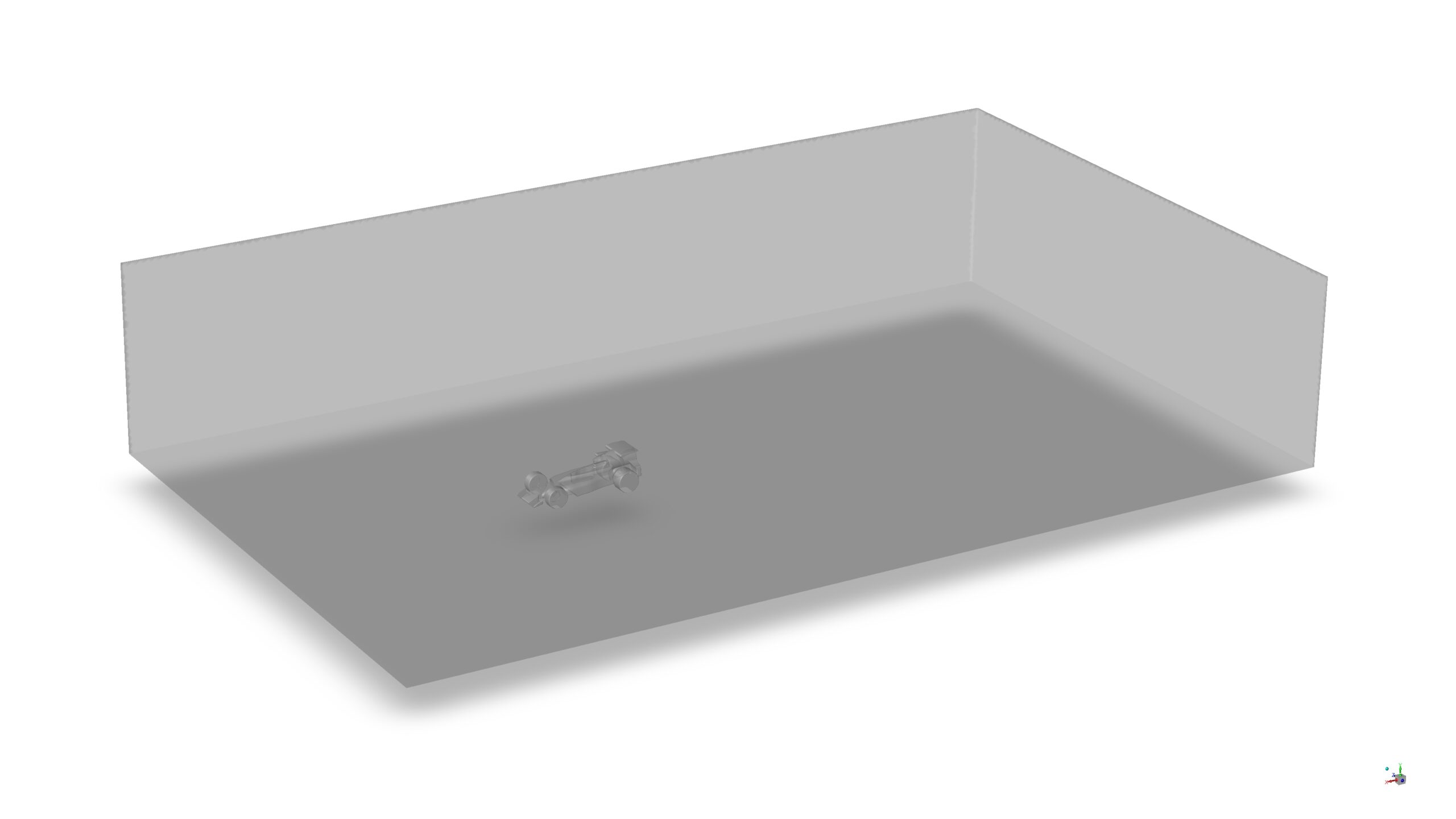
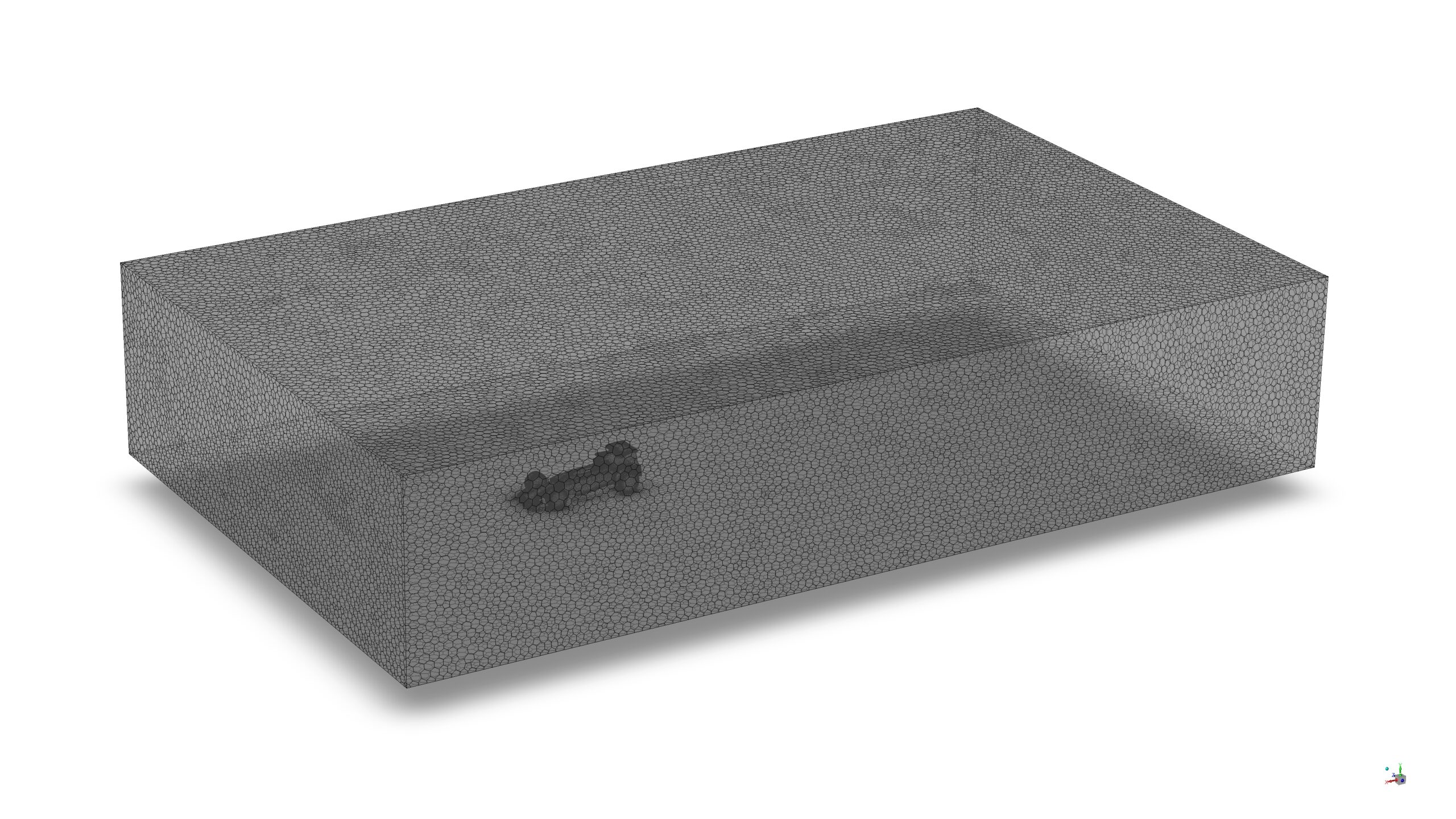
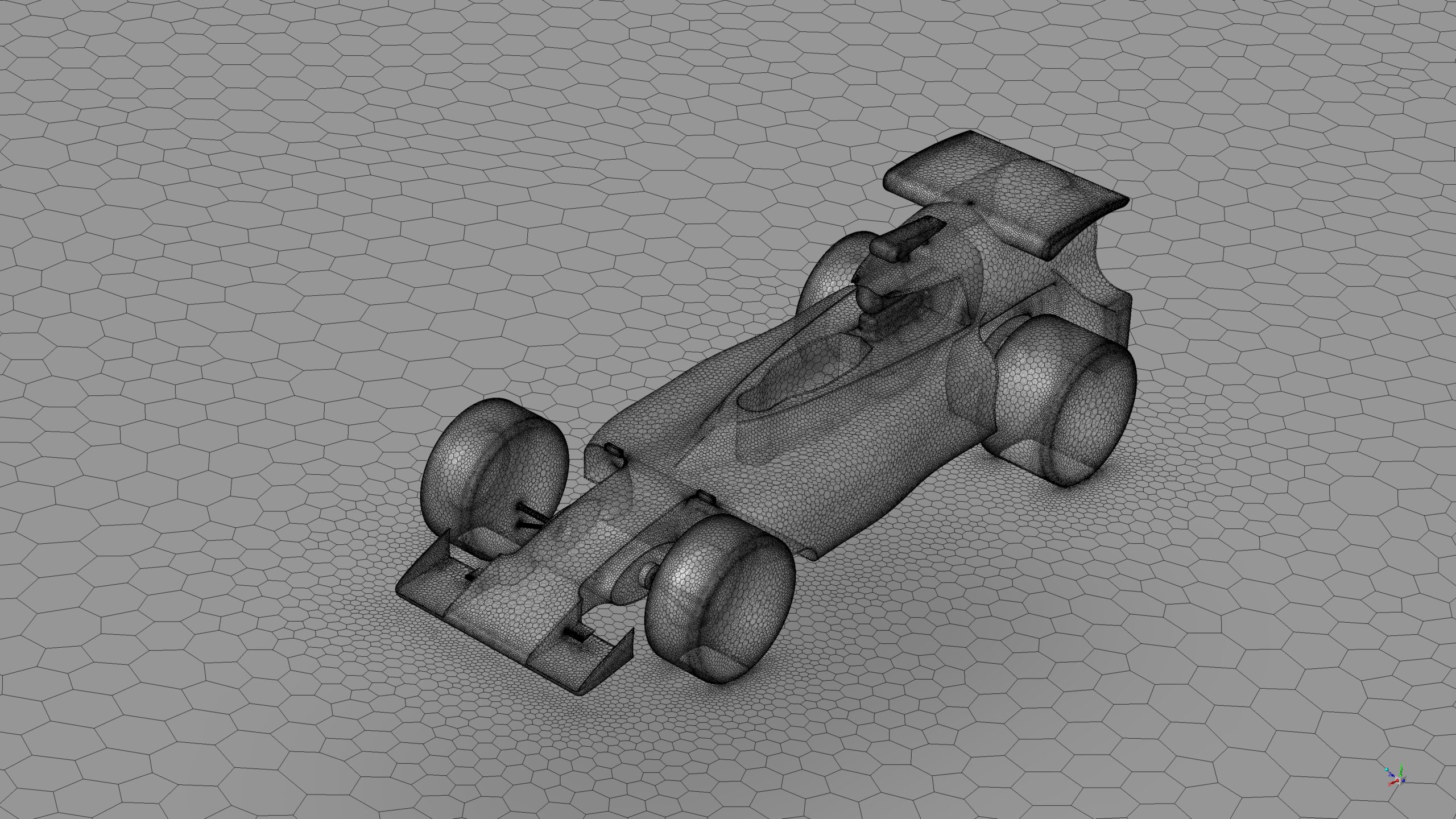
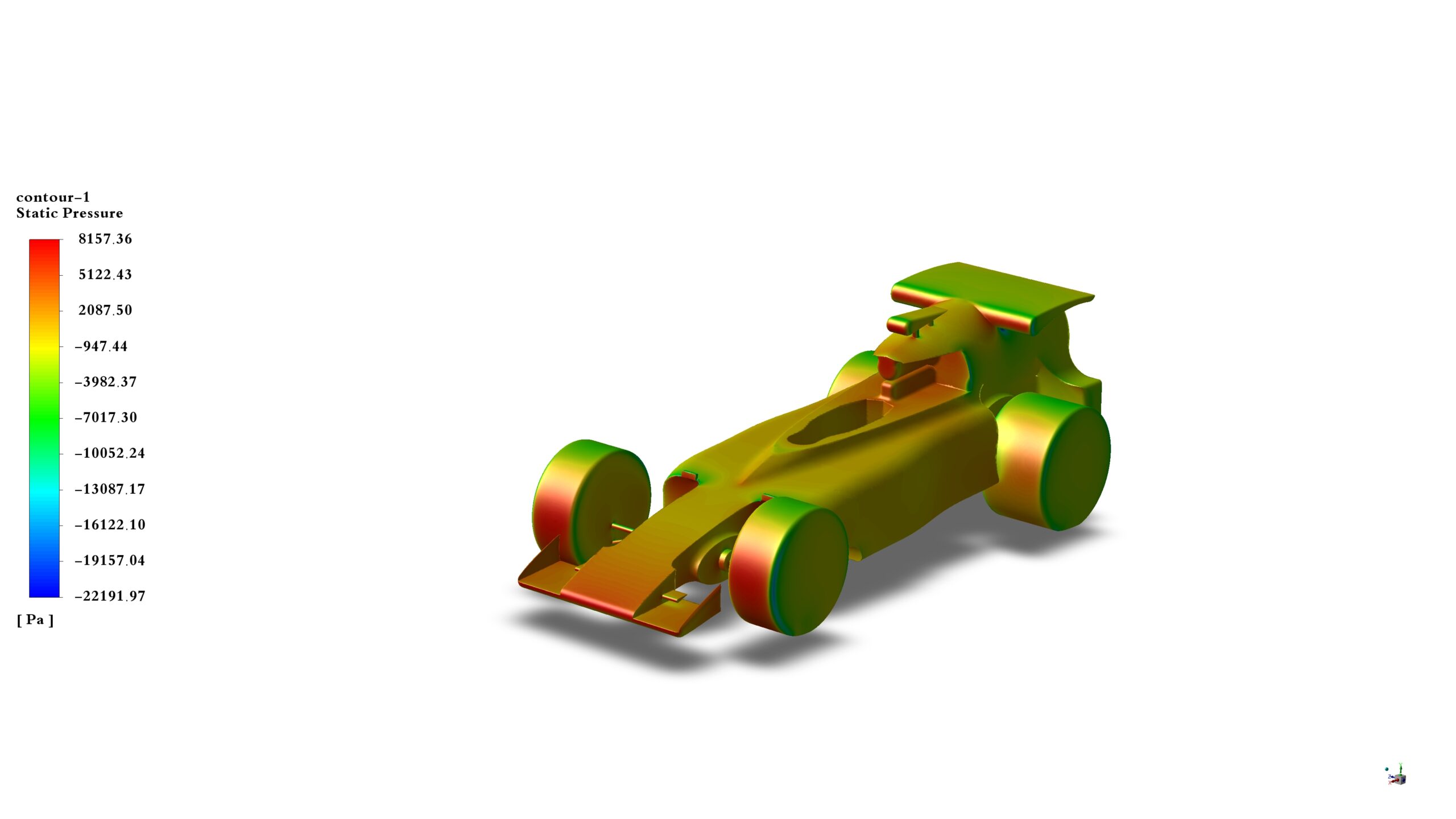


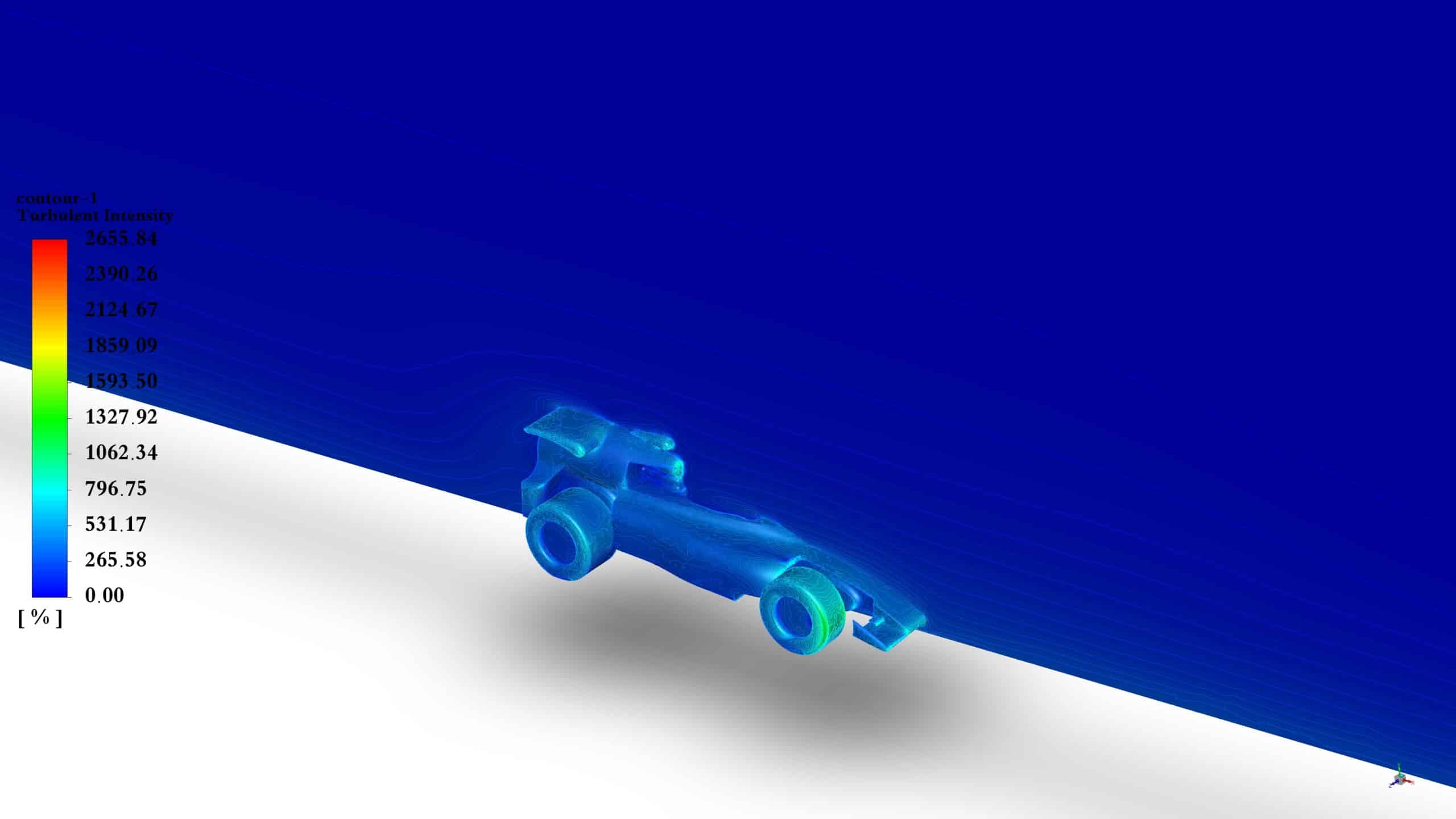
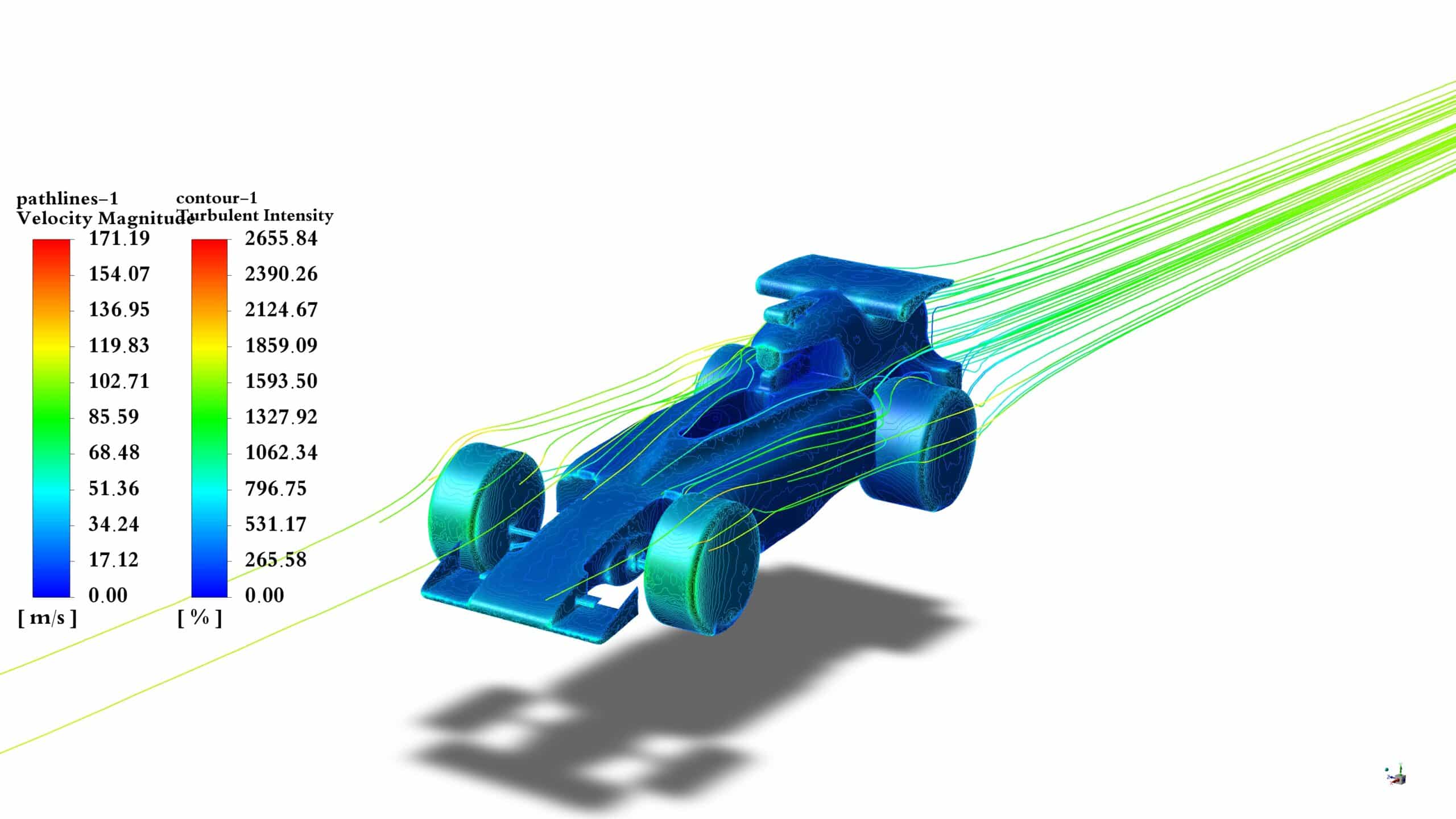
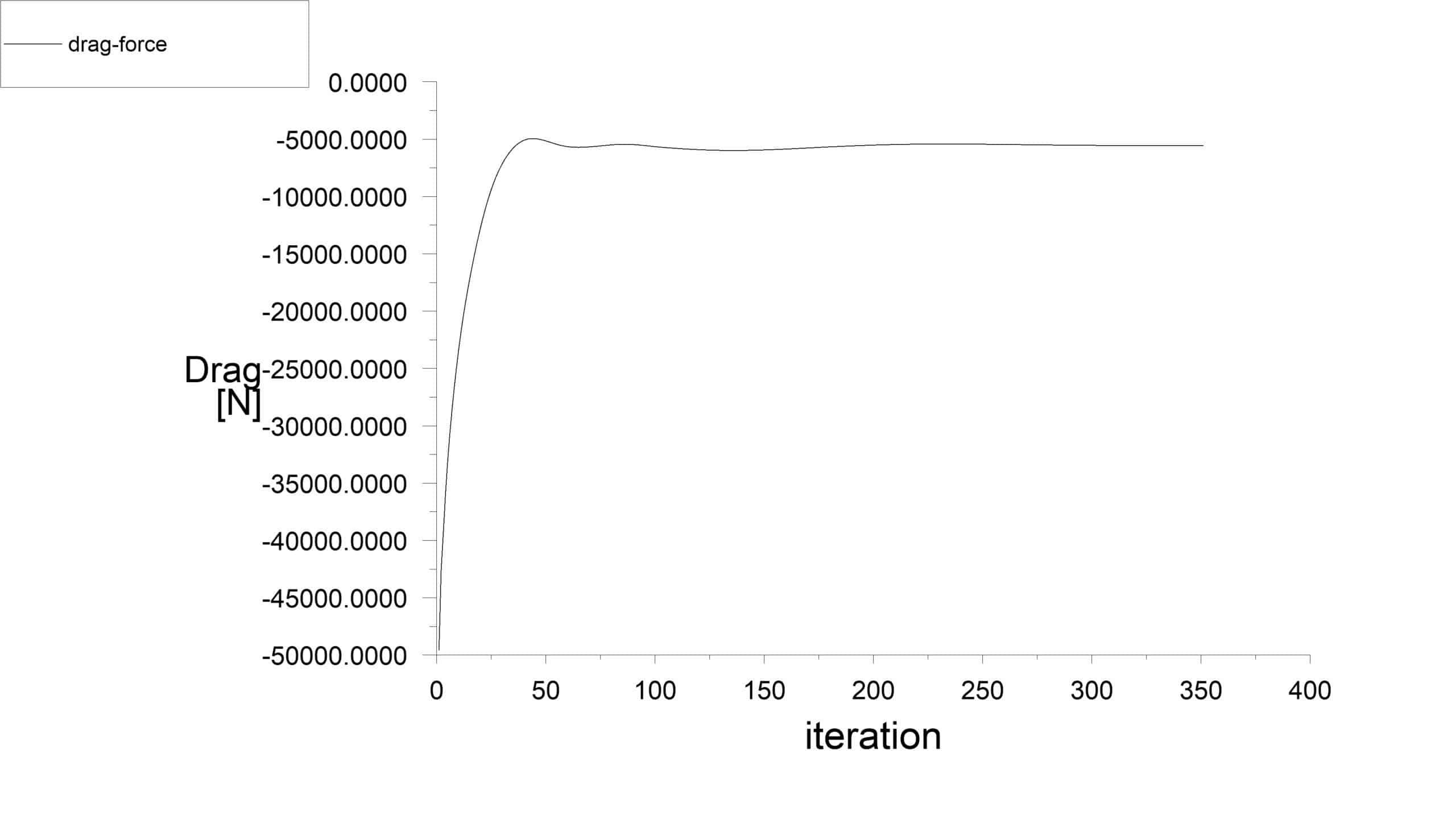
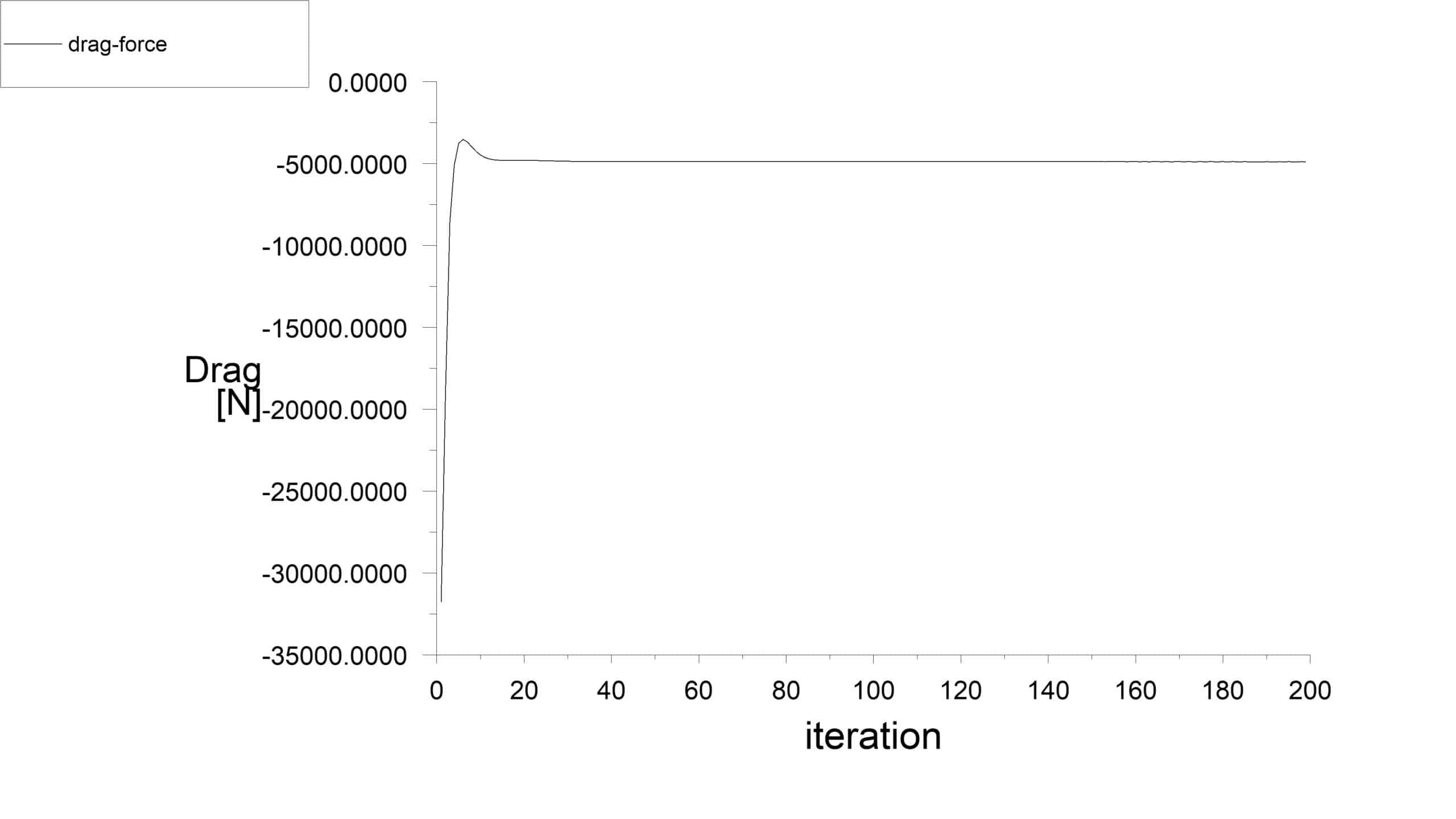
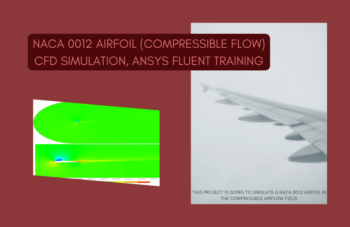
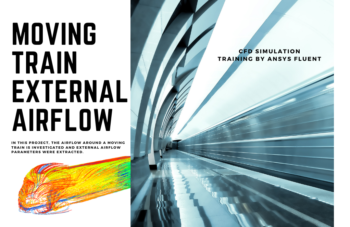
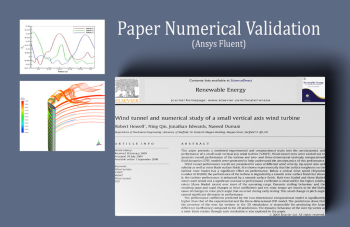

Melany Pollich –
I was impressed by the clarity of this simulation. The contrast between the density-based and pressure-based solvers for the F1 aerodynamics was fascinating. It really showed how computer simulations can make such a complex topic more understandable. Great work!
MR CFD Support –
We’re delighted to hear that you found the F1 aerodynamics CFD simulation to be clear and insightful. Understanding the different impacts of density-based and pressure-based solvers on the results is indeed a central aspect for professionals and enthusiasts alike. Thank you for your positive feedback!
Kasey Schaden –
Fantastic insights on the F1 aerodynamics! This comprehensive analysis under different solvers provides valuable information for predicting force interactions at high speeds. Moreover, the comparison offers clarity on solver efficiency and outcome accuracy—the use of clear, concise tables for drag force and iterations helps immensely.
MR CFD Support –
Thank you for the positive feedback regarding the F1 aerodynamics CFD simulation comparison. We’re thrilled that you appreciate the effort put into providing a detail-oriented and clear analysis, as well as the effort to make our results easily understandable. If you need further clarifications or assistance with your projects, feel free to reach out. Thank you once again for taking the time to share your thoughts.
Maegan Gaylord IV –
I’m truly impressed by the depth of the study and how both solvers were utilized. It’s fascinating to see a nearly negligible difference in drag force between the pressure-based and density-based solvers for a Mach number of 0.32. Can this analysis be extended to higher Mach numbers where flow becomes fully compressible, and would you still recommend pressure-based solvers in such cases?
MR CFD Support –
Thank you for your compliment! With regards to extending the analysis to fully compressible flow at higher Mach numbers, it’s important to note that the density-based solver would likely become the more accurate choice. The pressure-based solver is generally more suitable for incompressible or mildly compressible flows. At higher Mach numbers where compressibility effects become significant, the density-based solver is designed to capture shocks and expansions more effectively, making it the preferred method for those scenarios.
Dr. Allan Vandervort –
Is there a reason why the Pressure Based solver required fewer iterations for convergence compared to the Density Based solver in this simulation?
MR CFD Support –
The Pressure Based solver often requires fewer iterations because it is generally more robust and efficient for incompressible or mildly compressible flows, as it solves the pressure-velocity coupling equations directly. On the other hand, the Density Based solver is particularly tailored for high-speed compressible flows, where density changes significantly, such as supersonic and hypersonic regimes. In cases where the flow is approaching the transition between incompressible and compressible (such as a Mach number of 0.32 in this scenario), the Pressure Based solver can still handle the flow with fewer iterations while providing adequate accuracy, resulting in lower computational costs.
Mrs. Ashlynn Wolff Jr. –
I really loved the comprehensive comparison between the pressure-based and density-based solvers for the F1 aerodynamics simulation. The clarity in explaining the methodology, along with the details of convergence, gave me great insights into which solver is more cost-effective.
MR CFD Support –
We appreciate your positive feedback on our comparison of pressure-based and density-based solvers for F1 aerodynamics CFD simulation. It’s great to hear that our attention to detail and methodology provided you with valuable insights. Thank you for your kind words, and we look forward to providing more high-quality simulations to assist your learning experience!
Jayne Jacobs –
I am thoroughly impressed by the detailed analysis of the F1 car aerodynamics comparing pressure-based and density-based solvers. The side-by-side comparison of the drag force alongside convergence iterations provided a clear understanding of the trade-offs in computational cost versus accuracy within the subsonic regime for aerodynamic simulations.
MR CFD Support –
Thank you for your positive feedback! We’re delighted to hear that you found the aerodynamic analysis of the F1 car insightful and clear, especially the comparison between the pressure-based and density-based solver results. Your recognition greatly motivates our team. If you have any further questions or need additional information on our simulations, feel free to ask.
Prof. Doris Predovic –
I’m very impressed with the detailed analysis on the F1 car aerodynamics using both pressure-based and density-based solvers at such an important Mach number. Can you maintain accuracy consistently with the pressure-based solver for different car designs, or is it tailored to this specific F1 car model?
MR CFD Support –
Thank you for your wonderful feedback! The accuracy of using the pressure-based solver in CFD simulations does not solely depend on the car model itself, but rather on the overall flow regime you are analyzing. For subsonic flows, the pressure-based solver is generally preferred for its efficiency and accuracy. However, if dealing with flows where compressibility effects become significant, as with high-speed car designs at higher Mach numbers, the density-based solver might be more appropriate. Each car design induces unique aerodynamic characteristics, and convergence and accuracy will depend on ensuring proper physical modeling and boundary conditions. Rest assured, pressure-based solver methods have proven to be significantly dynamic and adapted successfully across a wide variety of car designs for aerodynamic analysis.
Miss Lucie Schaefer –
This product was extremely insightful for understanding F1 aerodynamics using CFD simulations. The detailed comparison between pressure-based and density-based solvers gave me a clear idea of which to choose for various speed regimes. The complex interplay of drag forces and the intricacies of convergence were well explained. Realizing the cost-effectiveness in terms of iterations needed for the pressure-based solver was particularly valuable information for my own simulations.
MR CFD Support –
Thank you for your positive feedback! We are delighted to hear that our F1 Aerodynamics CFD Simulation provided you with a clear understanding of the differences between pressure-based and density-based solvers. It’s great to know that the simulation helped you see the value of the pressure-based approach in terms of reducing computational cost. We appreciate you taking the time to share your experience with our product.
Dr. Braden Kovacek –
The information provided on F1 aerodynamics is fascinating. As someone who is passionate about motorsports and CFD, I found the comparison between pressure-based and density-based solvers particularly illuminating.
MR CFD Support –
Thank you for your kind words! We’re delighted to hear that our comparison between pressure-based and density-based solvers for F1 aerodynamics was enlightening for you. It’s our pleasure to provide insights that fuel your passion for motorsports and CFD simulation. Stay tuned for more engaging and informative content!
Prof. Grover Schimmel –
I found the comparison of pressure-based and density-based solvers for the F1 simulation enlightening. Great clarity in results representation. Keep up the fantastic work!
MR CFD Support –
Thank you for your kind words! We’re delighted that our comprehensive comparison provided clear insights and was helpful for understanding the aerodynamics of an F1 car. Your feedback is appreciated and motivates us to continue delivering quality simulations.
Norris Schaefer –
This project clearly illustrates the comparison between pressure-based and density-based solvers for F1 aerodynamics. Impressive analysis on the drag force and the iterative process for achieving convergence.
MR CFD Support –
Thank you for your positive feedback! We’re glad you found our comparison and analysis of the solvers within CFD simulation valuable. Feel free to reach out if you have any more questions or need further assistance with aerodynamic simulations.
Bennie Rodriguez –
I’m highly impressed with the comprehensive analysis provided between the pressure-based and density-based solvers for the F1 car’s aerodynamics. The intricate details, such as the realizable k-epsilon model for turbulence and the difference in convergence, provide clear insights for applications in similar projects.
MR CFD Support –
Thank you for your kind words! We’re delighted to hear that our comparative analysis on the F1 aerodynamics simulation was insightful and helpful for you. If you have any further inquiries or require assistance with future projects, please feel free to reach out. We are committed to providing high-quality information and support for your CFD simulation needs.
Prof. Julie Volkman –
I’m really impressed by the detailed comparison of pressure-based and density-based solvers for the F1 aerodynamics simulation. Your analysis seems thorough and gives clear insights on the effectiveness of each method for this specific Mach number and geometry.
MR CFD Support –
Thank you for your positive feedback! We take pride in providing comprehensive analyses to assist users in better understanding the nuances of various CFD approaches, especially in complex simulations like F1 aerodynamics. If you have any further questions or need more in-depth explanations about our products, feel free to reach out. We’re always here to help!
Tyrique Cole DVM –
The F1 simulation review was really insightful. I was wondering, why does the pressure-based solver require fewer iterations than the density-based to converge?
MR CFD Support –
In this simulation, the pressure-based solver likely requires fewer iterations because it is optimized for incompressible or mildly compressible flows, which is characteristic of many aerodynamic applications such as this F1 car at the given Mach number of 0.32. Its formulation and algorithms may converge more rapidly when density variations are not significant. On the other hand, the density-based solver, which is more suitable for highly compressible flows, may require a finer resolution of the flow features and more iterations to accurately capture the compressibility effects, resulting in the observed difference in the number of iterations for convergence.
Kadin Borer –
Could you explain which of the two methods is more suitable for race day conditions when quick decisions might be needed?
MR CFD Support –
For race day conditions where quick decisions are crucial, the Pressure-Based solver would be more suitable as it requires fewer iterations to converge, which means it can provide results faster, making it more time and computationally cost-efficient for scenarios where speed is a pivotal factor.
Sibyl Thiel DVM –
This F1 aerodynamics research is fascinating. I particularly appreciate the detailed comparison between the pressure-based and density-based solver outcomes. A tremendous job showing the iteration comparison for convergence!
MR CFD Support –
Thank you for your kind words! It’s great to hear that you found the comparison between the solvers and the detailed iteration data informative and helpful in understanding F1 aerodynamics CFD simulations.
Mr. Adonis Dietrich –
I’m truly impressed by the detailed analysis of the pressure-based and density-based solvers for F1 aerodynamics CFD simulation. Seeing the comparison in drag forces along with the iterations required for convergence offers a clear insight into the simulation precision and efficiency.
MR CFD Support –
Thank you for your complimentary review! We appreciate your recognition of the effort put into providing a comprehensive analysis of the CFD simulation. If there’s anything more you would like to know or discuss, feel free to ask. Meanwhile, we remain committed to delivering high-quality simulations for our customers.
Ms. Meaghan Koss –
I’m delighted with how comprehensive the F1 Aerodynamics CFD Simulation report is. The detailed comparison between pressure-based and density-based solvers and their respective convergence characteristics really gives me confidence in understanding the applications of each solver in CFD projects. Great job!
MR CFD Support –
Thank you for your compliment on the F1 Aerodynamics CFD Simulation report. We are thrilled to hear that the detailed analysis and solver comparison have enhanced your confidence in understanding the intricacies of CFD simulations. We strive to provide detailed and accurate information to aid in the decision-making process for solver applications. If you have any further questions or need more information, feel free to ask. Enjoy applying your new insights!
Kiel Runolfsson MD –
I’m impressed with the details of the F1 CFD simulation methodology! Does the report discuss the impact of the aerodynamic coefficients on the car’s performance in any depth?
MR CFD Support –
In the given document, the focus is primarily on the numerical study and comparison of drag coefficients using pressure-based and density-based solvers rather than a detailed analysis of how these coefficients affect the car’s performance. However, in general practice, understanding these coefficients is vital for optimizing the aerodynamics of the car for better stability and speed.
Dr. Bernardo Sipes –
The F1 Aerodynamics course was incredibly insightful. I am impressed with how thorough the explanations were on the pressure-based and density-based solvers, making it easy to understand how they affect drag coefficient calculations.
MR CFD Support –
We’re thrilled to hear how much you’ve enjoyed the F1 Aerodynamics course and that the information on different solvers was enlightening for you. We pride ourselves on providing clear and detailed explanations, so it’s wonderful to know we’ve succeeded. Thank you for taking the time to share your positive experience!
Gianni Schneider –
This was a fantastic learning opportunity! The detailed explanation of pressure-based versus density-based solvers was really enlightening. Seeing the practical computation of the aerodynamics of an F1 car and how each solver performed was both informative and impressive. Thank you for such a comprehensive and practical examination of these concepts in a real-world example.
MR CFD Support –
We really appreciate your positive feedback! It’s wonderful to hear that you found the CFD simulation enlightening and valuable. Providing practical knowledge with real-world examples is what we aim for. If there’s anything more you would like to explore or learn about, feel free to reach out. Thank you for choosing our learning product!
Reuben Ondricka –
I’ve learned so much about F1 aerodynamics from this simulation. The detailed comparison between pressure-based and density-based solvers was particularly insightful, and the clear results made it easy to understand their implications in the design and testing of racing cars. Excellent work building such a comprehensive and practical learning tool!
MR CFD Support –
We’re thrilled to hear that our F1 Aerodynamics CFD Simulation was both informative and valuable to you! Thank you for your positive feedback. At MR CFD, we aim to provide thorough and realistic simulation experiences. If you have any further interest or need assistance with other simulations, feel free to reach out to us.
Eulalia Rutherford –
The explanations here are very clear and detailed. I appreciate that both pressure-based and density-based solvers were used to showcase the differences in the simulation of a Formula One car aerodynamics. It seems like both methods led to coherent data which supports their respective usefulness depending on the simulation goals.
MR CFD Support –
Thank you for your appreciation! We’re glad you found the comparison between pressure-based and density-based solvers informative and helpful. We always strive to provide comprehensive data to aid our customers in understanding the dynamics of such complex simulations. Your feedback is valuable to us!
Triston Feil –
I’m impressed with the detail given to the comparison of pressure-based and density-based solvers for the F1 CFD simulation. It’s great that the simulation reaches convergence with both methods, but interesting that the pressure-based solver is more cost-effective in terms of time.
MR CFD Support –
Thank you for taking the time to review our F1 Aerodynamics CFD Simulation. We’re glad to hear that you appreciate the thorough analysis and comparison between pressure-based and density-based solvers. We always strive to provide detailed and high-quality learning products to help understand the subtleties of aerodynamic simulations. If you have any more feedback or questions, we’re here to help!